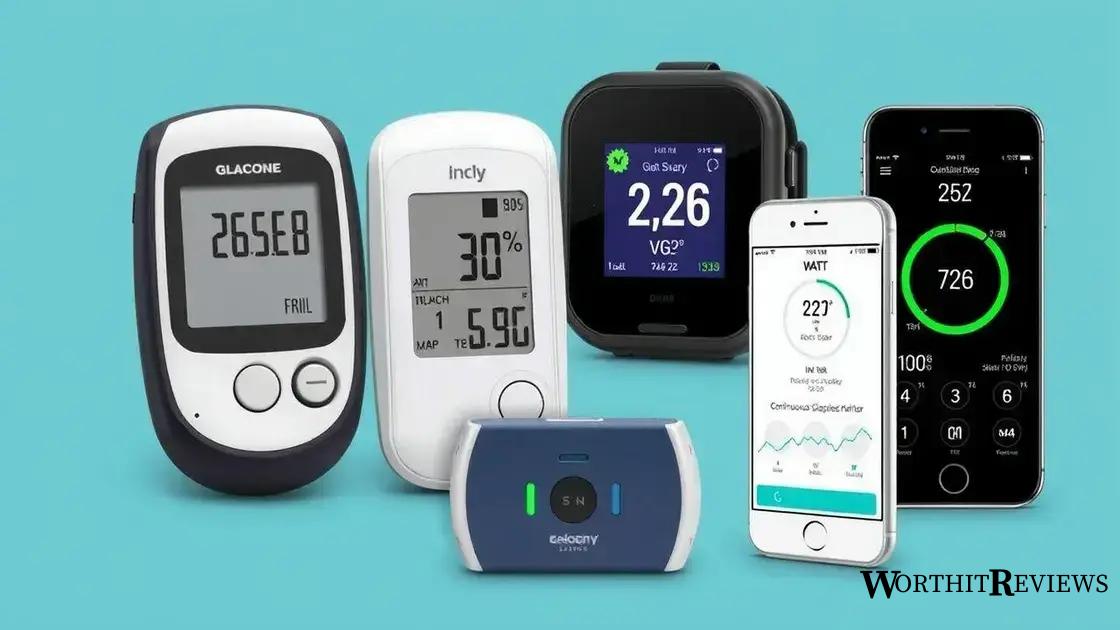Type 2 blood sugar levels can be effectively managed through regular monitoring, a balanced diet, regular exercise, and proper healthcare consultations to maintain optimal health and prevent complications.
Type 2 blood sugar levels play a crucial role in managing diabetes and overall health. Have you ever wondered how small changes can make a big difference? Let’s dive in and explore what that means.
Understanding type 2 diabetes and blood sugar levels
Understanding type 2 diabetes is essential for effective management of blood sugar levels. This condition occurs when the body becomes resistant to insulin or when the pancreas fails to produce enough insulin. Insulin is a hormone that helps regulate blood sugar levels, and when it doesn’t work properly, glucose can build up in the blood.
In type 2 diabetes, maintaining healthy blood sugar levels is vital. Usually, normal blood glucose levels should range between 70 and 130 mg/dL before meals and less than 180 mg/dL after eating. Consistently high blood sugar levels can lead to serious health issues, including nerve damage, heart disease, and kidney problems.
On the other hand, low blood sugar, or hypoglycemia, is also a concern. Symptoms may include shakiness, sweating, confusion, and even loss of consciousness. For individuals with diabetes, recognizing the signs of both high and low blood sugar is critical.
Monitoring your blood sugar is an important part of managing type 2 diabetes. This can be done using a glucose meter at home or continuous glucose monitors that provide real-time data. Keeping track of blood sugar levels helps individuals make informed decisions about their food, medication, and lifestyle choices.
What are healthy blood sugar levels?

Healthy blood sugar levels are essential for maintaining overall health, particularly for those with type 2 diabetes. Understanding what constitutes a healthy range can empower individuals to manage their condition effectively.
Typically, blood sugar levels are measured in milligrams per deciliter (mg/dL). For most adults, the normal fasting blood sugar level should be between 70 and 100 mg/dL. This reading is taken after not eating for at least eight hours.
After eating, blood sugar levels can rise. A postprandial (after meal) blood sugar level of less than 140 mg/dL is generally considered normal. However, for individuals with diabetes, it is crucial to aim for levels below 180 mg/dL within two hours after meals.
It’s important to note that these ranges can vary depending on individual health factors, medications, and age. Regular monitoring can help identify any fluctuations and allow for timely adjustments in lifestyle or medication.
Staying within these healthy levels can help prevent complications associated with diabetes, such as nerve damage, kidney disease, and heart problems. Individuals should consult healthcare professionals to establish personalized goals based on their specific health needs.
Factors influencing blood sugar levels in adults
Several factors can influence blood sugar levels in adults, and understanding them is crucial for effective diabetes management. These factors can be classified into dietary, lifestyle, medical, and emotional categories.
Diet plays a significant role in blood sugar regulation. Consuming foods high in carbohydrates can cause blood sugar levels to spike. Choosing whole grains, fruits, and vegetables while limiting refined sugars and processed foods can help maintain stable levels.
Physical activity is another crucial factor. Regular exercise helps improve insulin sensitivity and allows the body to utilize glucose more efficiently. Activities such as walking, cycling, and strength training are recommended to help keep blood sugar in check.
The timing of meals and portion sizes can also impact blood sugar levels. Eating smaller, more frequent meals can help prevent drastic fluctuations in glucose levels. It’s essential to monitor how different foods affect individual blood sugar responses.
Additionally, certain medications can influence blood sugar levels. For instance, medications for diabetes management should be taken as prescribed, as they play a critical role in controlling glucose levels.
Lastly, emotional well-being can impact blood sugar regulation. Stress and anxiety may lead to higher blood sugar levels, as cortisol releases can affect insulin sensitivity. Practicing stress-reduction techniques such as meditation or yoga can promote better health.
Symptoms of high and low blood sugar levels

Recognizing the symptoms of high and low blood sugar levels is essential for effective diabetes management. Both conditions can pose serious health risks, and being aware of the signs can help individuals take timely action.
High blood sugar, or hyperglycemia, may present several noticeable symptoms. Common signs include:
- Increased thirst
- Frequent urination
- Fatigue and weakness
- Blurred vision
- Dry mouth
- Nausea and vomiting
If left untreated, high blood sugar can lead to severe complications, so it’s important to monitor levels and adjust food intake or medications as needed.
On the other hand, low blood sugar, known as hypoglycemia, can occur when blood glucose levels drop too low. Symptoms of low blood sugar typically include:
- Shakiness
- Sweating
- Confusion or difficulty concentrating
- Dizziness
- Rapid heartbeat
- Irritability or mood changes
Severe hypoglycemia can lead to loss of consciousness or seizures, making it critical to address symptoms promptly by consuming fast-acting carbohydrates, like glucose tablets or juice.
Staying vigilant about these symptoms enables individuals to maintain better control over their blood sugar levels, leading to improved overall health and well-being.
Effective strategies to manage blood sugar levels
Managing blood sugar levels effectively is essential for individuals with type 2 diabetes. Implementing strategies can help maintain balanced blood glucose and promote overall health.
1. Monitor Blood Sugar Regularly: Keeping track of blood sugar levels helps identify patterns and triggers. Use a glucose meter to check levels regularly, adjusting diet or medication as needed.
2. Follow a Balanced Diet: A well-rounded diet rich in whole grains, fruits, vegetables, and proteins is crucial. Focus on consuming low glycemic index foods that raise blood sugar slowly. Limit refined sugars and processed carbohydrates.
3. Stay Hydrated: Drinking enough water helps with overall health and can prevent dehydration, which may affect blood sugar levels. Aim to drink at least eight glasses of water daily.
4. Exercise Regularly: Physical activity boosts insulin sensitivity, allowing the body to use glucose more effectively. Aim for at least 150 minutes of moderate-intensity aerobic exercise each week, combined with strength training.
5. Manage Stress: Stress levels can elevate blood sugar. Incorporate stress-reducing activities like yoga, meditation, or deep breathing exercises into your routine.
6. Get Enough Sleep: Quality sleep is important for blood sugar regulation. Aim for 7-9 hours of sleep each night, and establish a calming bedtime routine.
7. Consult with Healthcare Providers: Regular check-ups with healthcare professionals help tailor a management plan to individual needs. Discuss any changes in blood sugar patterns or new symptoms.
The role of diet in blood sugar control

The diet plays a crucial role in managing blood sugar levels, especially for those with type 2 diabetes. Selecting the right foods can help balance blood glucose and improve overall health.
First, it is important to focus on whole foods. These include fresh fruits, vegetables, whole grains, lean proteins, and healthy fats. Such foods provide essential nutrients and help maintain stable blood sugar levels.
Carbohydrate counting is another effective strategy. Understanding how many carbohydrates are in meals can aid in managing blood sugar. Aim to consume complex carbohydrates, such as oats and brown rice, rather than simple sugars found in sodas and candies.
Portion control is key as well. Eating smaller meals throughout the day can prevent spikes in blood sugar. Incorporating snacks, like nuts or Greek yogurt, can help keep levels steady.
Including fiber-rich foods in your diet is beneficial. Foods high in fiber, such as legumes, fruits, and vegetables, can slow digestion and help control blood sugar levels. Aim for at least 25 grams of fiber per day.
Additionally, it is wise to limit processed foods and sugary drinks. These items are often high in refined sugars and can lead to rapid increases in blood sugar. By focusing on natural, unprocessed foods, individuals can improve their blood sugar control.
Staying hydrated is also important. Drinking plenty of water helps the kidneys flush out excess sugar through urine. Aim for at least eight glasses of water daily to stay hydrated.
Exercise and its impact on blood sugar levels
Exercise plays a significant role in managing blood sugar levels, especially for individuals with type 2 diabetes. Regular physical activity helps the body use insulin more effectively.
When you engage in exercise, your muscles utilize glucose for energy. This process can lead to lower blood sugar levels during and after physical activity. It’s essential to include a mix of both aerobic exercises and strength training in your routine for optimal results.
Aerobic exercises, such as walking, jogging, cycling, or swimming, can significantly enhance cardiovascular health while effectively lowering blood sugar. Aim for at least 150 minutes of moderate-intensity aerobic exercise each week.
Strength training also has benefits for blood sugar control. Activities like weight lifting or resistance exercises help build muscle mass, which can improve insulin sensitivity. Try to include strength training exercises at least twice a week.
Additionally, integrating physical activity into daily routines can help maintain stable blood sugar levels. Simple actions like taking the stairs instead of an elevator or walking during breaks at work can make a significant difference.
It’s important to monitor your blood sugar levels before and after exercise. This ensures that any necessary adjustments can be made to medications or food intake to prevent hypoglycemia.
In conclusion, regular exercise not only enhances physical fitness but also contributes to better blood sugar management, leading to improved overall health.
Monitoring your blood sugar: tools and techniques

Monitoring your blood sugar levels is essential for managing diabetes effectively. There are several tools and techniques available to help you keep track of your blood glucose levels.
1. Glucose Meters: These handheld devices are the most common tool for measuring blood sugar. You can obtain a small blood sample from a fingertip, which is then placed on a test strip inserted into the meter. Results typically appear within seconds, allowing for quick adjustments in diet or medication.
2. Continuous Glucose Monitors (CGMs): CGMs are advanced devices that provide real-time blood sugar readings. A small sensor is placed under the skin, allowing for continuous monitoring throughout the day. This method helps detect trends and patterns in blood sugar levels, making it easier to manage your condition.
3. Smart Devices and Apps: Many people use smartphone applications or smart devices that sync with glucose meters or CGMs. These tools can help log and track blood sugar levels, food intake, exercise, and medication. Analyzing this data can provide insights and patterns, assisting in better management.
4. Regular Check-ups: Regular appointments with healthcare providers are vital for monitoring your diabetes. During these visits, you can discuss your blood sugar patterns, receive advice, and make necessary adjustments to your management plan.
5. Food Diaries: Keeping a food diary can also aid in monitoring blood sugar levels. By recording what you eat along with your blood sugar readings, you can identify how different foods affect your glucose levels and make more informed dietary choices.
Managing Blood Sugar Levels for Better Health
In conclusion, understanding and managing your blood sugar levels is crucial for your overall health, especially for those with type 2 diabetes. By using the right tools, such as glucose meters and continuous glucose monitors, you can actively track your levels and make necessary adjustments.
Incorporating a balanced diet, regular exercise, and stress management practices can also greatly enhance your ability to maintain stable blood sugar levels. Remember, consulting with healthcare providers helps tailor your management plan to your specific needs.
By staying proactive and informed, you can effectively manage your blood sugar levels and improve your quality of life.
